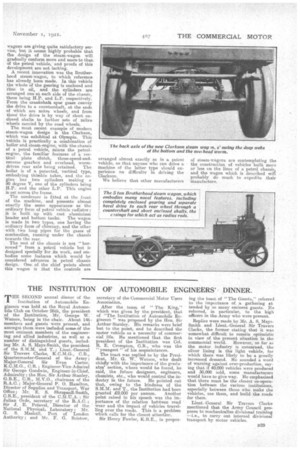PROGRESS IN STEAM WAGON DESIGN.
Page 18

Page 19

If you've noticed an error in this article please click here to report it so we can fix it.
Weight Reductions. Boiler Modifications. New Chassis. Simplifying Controls.
FOR many years the .steam-wagon has laboured under the disadvantage of being, to all intents and purposes, a development of the traction engine, and in many cases was little more than a traction engine adapted for the carrying of goods. Even the adoption of solid rubber tyres did little at first in making it other than a heavy, unwieldy machine, often unsuitable for the increased speed which the use of these tyres rendered permissible.
During recent years, however, the conservatism of the steam-wagon designer has been gradually overcome. At first it was found possible, with the assistance of the metallurgist, considerably to reduce the weights of the various parts used in steam-wagon construction, even though the old features of a massive, live rear axle, open chain drive, exposed differential and traction engine steering were retained.
B28 Later, however, certain makers became dissatisfied with the amount of
space occupied by the loco.-type boiler, and various other types and modifications were introduced, including the vertical, such as are used en the Sentinel and Atkinson wagons, and the doubleended loco.-type positioned across the front, as in the case ofthe Yorkshire and Brotherhood wagons. At the seine time, the erode, centrally pivoted axles and chain steering gears began to be replaced by stub axles and Ackermann steering gears, the wheels being dished in order to give centre point steering. In certain other respects, however, many of these wagons were still heavy and somewhat crude in their, design, this applying par
ticularly to the final drives. In some cases little or no attempt was made to shield the differential gear.
A certain measure of success was attained by protecting the differential gears from the deleterious effects of mud and stones, and some of these improved Wagons are giving quite satisfactory service, but it seems highly probable that the design of the steam-wagon will gradually conform more and more to thatof the petrol vehicle, and proofs of this development are not lacking.
A recent innovation was thq Brotherhood steam-wagon to which reference has already_ been made. In this vehicle the whole of the gearing is enclosed and runs in oil, and the cylinders are arranged one at each side of the chassis, these being H.P. and L.P. respectively. From the crankshaft spur gears convey the drive to a countershaft, at the ends of which are mitre wheels, and from these the drive is by way of short enclosed shafts to further sets of mitre wheels carried by the road wheels. The most recent example of modern steam-wagon design is the Clarkson, which was exhibited at Olympia. This vehicle is practically a. combination of boiler and steam-engine, with the chassis of a petrol vehicle, minus the petrolengine, the familiar features of a vertical plate clutch, three-speed-and. reverse gearbox and overhead worm driven rear axle being retained. The boiler is of a patented, vertical type, embodying thimble tubes, and the engine has two cylinders making a 90 degree V, one of the cylinders being H.F. and the other L.P. This engine is set across the frame.
The condenser is fitted at the front of the machine, and presents almost exactly the same appearance as the ordinary form of petrol vehicle radiator; it is built up with cast aluminium header and bottom tanks. The wagon is made in two types, one having the ordinary form of cYumney, and the other with two long pipes for the gases of combustion, running under the chassis towards the rear.
The rest of the chassis is not "borrowed " from a petrol vehicle but is designed specially for ,its work, and embodies some features which would be considered advances in petrol chassis design. One, of the chief points about this wagon is that the controls are arranged almost exactly as in a petrol vehicle, so that anyone who can drive a machine of the latter type should experience no difficulty in driving the Clarkson.
We believe that other manufacturers of steam-wagons are contemplating the the construction of vehicles built more or less on the lines of a petrol chassis, and the wagon which is described will probably do much to expedite their manufacture.
































